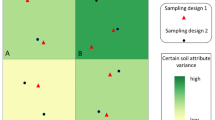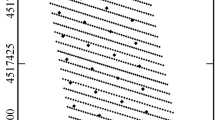Abstract
This chapter discusses methods for soil sampling that allow calibration of proximal sensor readings to soil properties. Conditioned Latin hypercube sampling (cLHS) was recently proposed as a method for sampling based on covariates obtained from proximal soil sensors. The method provides full coverage of the range of each variable by maximally stratifying the marginal distribution. A modification of cLHS was made so that it samples more on the edge of the distribution. This modification, called DLHS, is inspired by the D-optimality criterion in linear regression, where the design will place sample points on the corner of the distribution. We run a simulation to test the performance of cLHS. The simulation assumed a known form of the response function of EM38, EM31, and elevation to clay content. Results showed that when the form of the model is known, it is beneficial to place more sample points on the corners of the hypercube. When the form is unknown, conventional cLHS performs better.
Access this chapter
Tax calculation will be finalised at checkout
Purchases are for personal use only
Similar content being viewed by others
References
Brus DJ, Heuvelink GBM (2007) Optimisation of sample patterns for universal kriging of environmental variables. Geoderma 138:86–95
de Gruijter JJ, McBratney AB, Taylor J (2008) Sampling for high resolution soil mapping. Global workshop on high resolution digital soil sensing and mapping. The University of Sydney, Australia, 5–8 February 2008
Lesch SM (2005) Sensor-directed spatial response surface sampling designs for characterising spatial variation in soil properties, Comput Electron Agric 46:153–180
McBratney AB, Minasny B, Whelan BM (2005) Obtaining ‘useful’ high-resolution soil data from proximally-sensed electrical conductivity/resistivity (PSEC/R) surveys. Precision Agriculture ’05. Stafford JV (ed) pp 503–510
McKay MD, Beckman RJ, Conover WJ (1979) A comparison of three methods for selecting values of input variables in the analysis of output from a computer code. Technometrics 21:239–245
Minasny B, McBratney AB (2006) A conditioned Latin hypercube method for sampling in the presence of ancillary information. Comput Geosci 32:1378–1388
St. John RC, Draper NR (1975) D-optimality for regression designs: a review. Technometrics 17:15–23
Acknowledgement
We thank Jaap de Gruijter for his comments and suggestions on the chapter.
Author information
Authors and Affiliations
Corresponding author
Editor information
Editors and Affiliations
Rights and permissions
Copyright information
© 2010 Springer Science+Business Media B.V.
About this chapter
Cite this chapter
Minasny, B., McBratney, A. (2010). Conditioned Latin Hypercube Sampling for Calibrating Soil Sensor Data to Soil Properties. In: Viscarra Rossel, R., McBratney, A., Minasny, B. (eds) Proximal Soil Sensing. Progress in Soil Science. Springer, Dordrecht. https://doi.org/10.1007/978-90-481-8859-8_9
Download citation
DOI: https://doi.org/10.1007/978-90-481-8859-8_9
Published:
Publisher Name: Springer, Dordrecht
Print ISBN: 978-90-481-8858-1
Online ISBN: 978-90-481-8859-8
eBook Packages: Earth and Environmental ScienceEarth and Environmental Science (R0)




